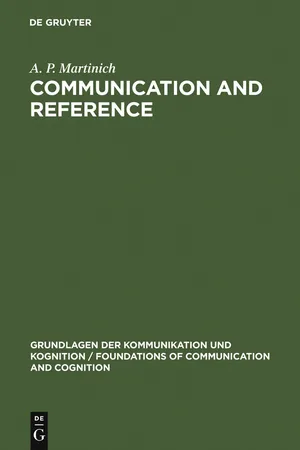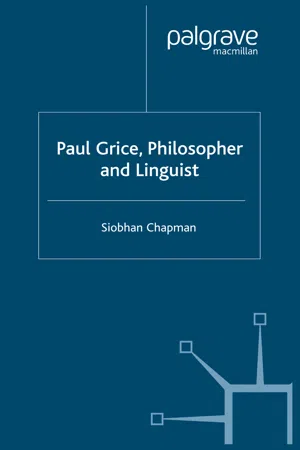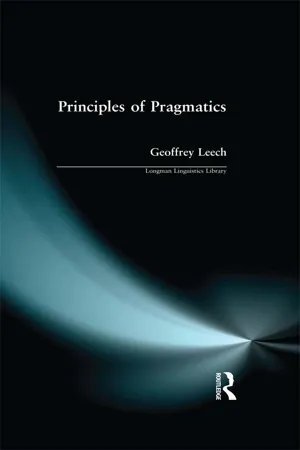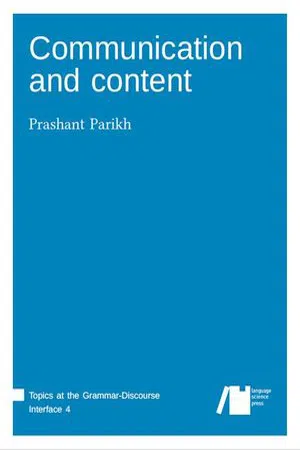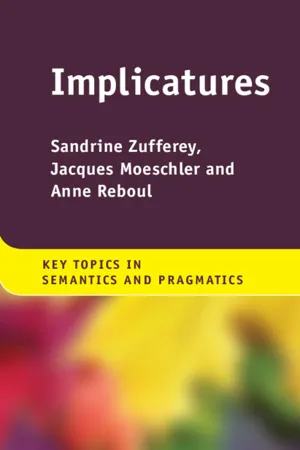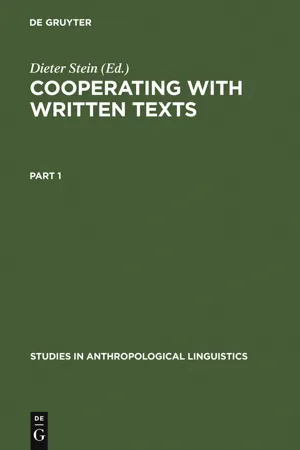Languages & Linguistics
Cooperative Principle
The Cooperative Principle is a concept in linguistics proposed by philosopher H.P. Grice. It suggests that in conversation, people tend to cooperate by following certain principles, such as being truthful, relevant, and clear. This principle helps to explain how people understand implied meanings and make inferences during communication.
Written by Perlego with AI-assistance
Related key terms
1 of 5
8 Key excerpts on "Cooperative Principle"
- eBook - PDF
- A. P. Martinich(Author)
- 2012(Publication Date)
- De Gruyter(Publisher)
There is, for example, the general requirement that a hearer try to understand what the speaker means, even if he has to ignore the literal meaning of the words that the speaker utters. This requirement, which obviously follows from the Cooperative Princi-ple, explains why defective utterances so often succeed in communicating the speaker's meaning to the hearer. Despite grammatical errors (One of II The Cooperative Principle and Conversational Maxims 21 the trees are blooming), solecisms (The cat laid down on the sofa), mis-pronunciations (This course was not reverent [relevant] to me), and mis-descriptions (Margaret Thatcher is the president of England), the hearer generally succeeds in interpreting the speaker's utterances correctly. So deep and perversive is this principle that hearers are often oblivious to the defects of utterances; they make the necessary adjustments without con-scious effort (or perhaps they simply hear what they expect to hear rather than what is actually being uttered; this very often works, precisely because the purpose that the participants in a conversation share generates a com-mon set of expectations). The Cooperative Principle is revealing and important, but because of its generality it is not terribly informative. In order to understand the structure of conversation, we need to know what specific rules the participants ob-serve. Grice mentions a number of rules of this sort, which he calls Con-versational Maxims and sets out in four groups: There are maxims of quantity, maxims of quality, maxims of relation, and maxims of manner. - eBook - ePub
- John Flowerdew(Author)
- 2012(Publication Date)
- Routledge(Publisher)
CHAPTER 6The Cooperative Principle and Politeness
6.1 INTRODUCTION
In the previous chapter, we referred to Searle’s concept of the indirect speech act. The phenomenon of indirect speech draws attention to the fact that there is not necessarily a one-to-one relation between what we say and the meaning of the sentences we use when their literal meanings are taken in isolation. Searle was first a philosopher before he was a linguist. Another philosopher of language, who came before Searle, was Grice. In this chapter, we will be talking about Grice and his concept of conversation (and other forms of language) as the cooperative interaction of two parties in the development of a common set of purposes. Grice referred to this as the ‘Cooperative Principle’ (CP). Following this discussion of the CP, the chapter will move on to consider the related phenomenon of politeness, another essential aspect of human interaction. We will consider how politeness relates to the CP, the conventions which are followed in order to maintain ‘polite’ behaviour, and different conceptions of how politeness might best be modelled and analysed. - eBook - PDF
Paul Grice
Philosopher and Linguist
- S. Chapman(Author)
- 2005(Publication Date)
- Palgrave Macmillan(Publisher)
Another criticism of Grice’s theory that seems off-beam in the light of his unpublished justification, but registers a legitimate concern for linguists, is that it works for only one particular discourse type: roughly for conversations between social equals who are mutually interested in exchanging information on a particular topic. Some of the earliest commentaries on the theory of conversation to consider the social and institutional contexts of language were, perhaps surprisingly, from philosophers rather than from linguists. In a 1979 edition of The Philo- 192 Paul Grice, Philosopher and Linguist sophical Quarterly, David Holdcroft and Graham Bird contribute to a dis- cussion of whether the Cooperative Principle is best seen as applying to all sequences of speech acts, or simply to informal conversations. Holdcroft argues that the Cooperative Principle is not unproblemati- cally universal across all sequences; in cases where participants do not ‘have equal discourse rights’ the maxims do not straightforwardly apply. 33 He offers the examples of the proceedings of a court of law and a viva exam, suggesting that different sets of maxims are accepted by participants in different cases. Bird argues that situations in which par- ticipants have unequal rights do not pose the problems to Grice that Holdcroft envisages; maxims may be suspended by mutual agreement without offering counter-examples to the theory. 34 These ideas were later addressed by linguists using actual conversa- tional data rather than theorised ‘types’ of sequences. Norman Fair- clough pioneered critical discourse analysis, an approach concerned with relating the formal properties of texts to interpretation and hence to their relationship to social context. He suggests that mainstream dis- course analysis ‘has virtually elevated cooperative conversation between equals into an archetype of verbal interaction in general’. - eBook - ePub
- Geoffrey N. Leech(Author)
- 2016(Publication Date)
- Routledge(Publisher)
Chapter 4The interpersonal role of the Cooperative Principle
It is undesirable to believe a proposition when there is no ground whatever for supposing it true.[Russell, Sceptical Essays , p. 1]Jack : Gwendolen, it is a terrible thing for a man to find out suddenly that all his life he has been speaking nothing but the truth. Can you forgive me?[Wilde, The Importance of Being Earnest , Act III]In the remaining chapters, I shall investigate the interpersonal rhetoric in greater depth than has so far been possible. In this way, I shall be seeking answers to some major problems at the ‘pragmatic end of semantics’, by seeking to apply the model outlined in Chapters 2 and 3 to the description of English. I shall be considering, in particular, how to deal with politeness phenomena, illocutionary force, performatives, indirect illocutions, and the meanings of speech-act verbs. In this, I shall be treading some familiar ground, but the approach I shall use will be to some extent unfamiliar. For example, I shall be trying to show exactly how the CP and the PP interact in the interpretation of indirectness. If I can show that both these principles are required to account for pragmatic interpretations, I shall be on the way to explaining the need for a ‘rhetoric’, in the sense of a set of principles which are observed in the planning and interpretation of messages.4.1 The Cooperative Principle (CP) and the Politeness Principle (PP)
So much has been written in general support of Grice’s concept of the CP that I may take this principle to some extent for granted. But it is necessary to give some explanation here of (a) why the CP is needed, and (b) why it is not sufficient, as an explanation of the relation between sense and force. It will also be necessary to consider the function, in the present model, of each of its constituent maxims (see 4.2 –5 - eBook - PDF
- Prashant Parikh(Author)
- 2019(Publication Date)
- Language Science Press(Publisher)
In o ther words, the Gricean maxims are completely superfuous. 17 As we will see, however, the Cooperative Principle is required. Grice’s theory of conversation also assumed the pipeline theory of meaning where the syntax of the sentence u tered is de termined frst, then its semantics (i.e. its literal meaning), and fnally its pragmatics (i.e. its implicatures). Te im-plicatures were derived from the literal meaning and other facts of the u terance. As I have shown earlier, 18 literal meaning and implicature can in fact be interde-pendent as all meanings tend to be. Tis two-way infuence will be discussed in detail in Part IV. I will show, in fact, that not only are the various meanings of an uterance in terdependent but so are these meanings and the optimal parse of the u terance. In o ther words, the implicature can depend in part on the optimal parse and vice versa. To conclude this section, I point out that the Gricean theory of conversation is really a theory of interpretation and not communication. While it is two-sided, it has litle to say about the speaker’s calculations. It also ofers nothing about how literal meaning is to be derived and one is forced to surmise that Grice probably meant this to be addressed by convention. While conventional meaning does play an important role in the determination of literal meaning, the process is ineluctably contextual as I have shown before and will show in even greater detail in this book. 5.3 Speaker meaning and word meaning As I said toward the end of Section 3.1, Grice wanted to reduce the intentionality of language, its aboutness or acquisition of meaning, to the intentions and beliefs of speakers, with the idea that these mental states could be further reduced to physical facts. Tis would explain how meaning could be part of the natural order. In his view, the key notion to efect such a reduction was that o f speaker meaning. - eBook - PDF
- Sandrine Zufferey, Jacques Moeschler, Anne Reboul(Authors)
- 2019(Publication Date)
- Cambridge University Press(Publisher)
Generalized conversational implicatures are context inde- pendent, while particularized conversational implicatures are con- text dependent. Finally, Grice insisted on the very existence of the cooperative assumption (the assumption that the speaker complies with the Cooperative Principle), determinacy and common know- ledge, in the so-called Generative Assumption. However, there are reasons to think that the Generative Assumption is not valid and the mechanism proposed by Grice has been criticized on several counts. First, there is a very basic objection to the effect that, while the Cooperative Principle seems strongly linked to the assumptions that the interests of the cooperators coincide, this may fairly often fail to be the case, and indeed, one might claim, as Pinker (2007) does, that implicatures exist to allow the speaker to deny manipulative intentions. Second, the Cooperative Principle and the maxims tend to overgenerate implicatures, allowing the hearer to derive from a single utterance two implicatures which contradict each other. In other words, the Cooperative Principle and the maxims do not adequately determine what the speaker implicated by her utterance. Finally, the maxims may conflict in some cases, leading to an interpretation which does not satisfy all of them. Thus, while the notion of implicature still very much occupies the centre of the pragmatic stage, the Gricean mechanism has been amended in various ways, as will be seen in the following chapters. More broadly, the arrival of pragmatics on the linguistics scene in the middle of the twentieth century has raised questions about the rela- tionship between linguistic theory and pragmatics, as we now outline. DISCUSSION QUESTIONS • What triggered the emergence of ordinary language philosophy? • What is the main difference between speech act theory on the one hand, and Grice’s notion of non-natural meaning and his logic of conversation on the other? - eBook - PDF
Cooperating with Written Texts
The Pragmatics and Comprehension of Written Texts
- Dieter Stein(Author)
- 2011(Publication Date)
- De Gruyter Mouton(Publisher)
If a reader understands Grice's principles, she can resist a great many more manipulative passages than she can if she is equipped only with a list of seventeen unconnected traditional fallacies. An understanding of Grice's principles can yield readers and writers improved critical abilities in their approaches to text. The Gricean perspective also explains why the use of fallacies and manipulative language is so profoundly uncooperative: the manipulative arguer unilaterally substitutes his own aim (to change the hearer's or reader's beliefs) for the ostensibly mutually accepted aim of the interac-tion. Use of manipulative language thus flies in the face of the Cooperative Principle. 5. Grice for Undergraduates Can a Gricean perspective be integrated into composition classes? Just a few remarks will indicate how I think a Gricean approach is both appropriate and accessible for composition students. Basic to the statement of the Cooperative Principle is the idea that contributions, whether in actions, talk or text, are evaluated for their acceptability in terms of the mutually understood purpose of the under-taking at hand. In evaluating a passage in a text, readers can best understand the logic of the passage if they have a reasonable understand-ing of the author's purpose: learning to find a purpose for the text, in both reading and writing, is one of the basic aims of composition classes. Consequently, learning to evaluate a portion of text in terms of that purpose — with Gricean principles as tools — can sensibly be integrated into composition courses. The learning of fallacies, however we may name them, is a case in point. Examples of fallacies in the infamous lists are seldom tied into larger stretches of text or discourse, and are thus difficult to evaluate in terms of purpose. Learning to look for violations, - eBook - PDF
- Joan Cutting(Author)
- 2014(Publication Date)
- EUP(Publisher)
Examine the concordance lines (see Chapter 2) to find the main speech act that ‘I’m sorry’ fulfils, and see whether it is always expressive of apologising. Choose ten lines that represent the most frequent speech acts involved and bring them to class. Discuss what classroom task you would design for 15–16 year olds, and what part of their current syllabus and coursebook would accommodate this task. 7.2 OBSERVING AND FLOUTING THE COOPERATIVE MAXIMS The Cooperative Principle (CP) stems from the work of Grice (1975). He understood that, in successful communication, interlocutors assume that they are obeying four maxims. These maxims are illustrated here with data from the COCA corpus: • The maxim of Quantity , which says that speakers should be as informative as is required, and give neither too little nor too much information. When speakers point to the fact that they are adhering to this maxim, they use expressions like ‘in brief ’ or ‘Anyway, to cut a long story short, th – they deported me, they put me on a plane back home.’ • The maxim of Quality , which says that speakers are presumed to be sincere, to be saying something that they believe is true. Some speakers emphasise the truth value of their words, as in ‘he didn’t return after that, as far as I know ’ and ‘To be honest with you, we have a lot left to do.’ • The maxim of Relation , which says that speakers are expected to be saying some-thing that is relevant to what has been said before. Some point to the relevance: ‘Oh you know what, that reminds me of something.’ 136 speech act theory and the Cooperative Principle • The maxim of Manner , which says that we should avoid ambiguity. Speakers emphasising this use expressions such as ‘When I say couple of times, I mean, like ten or twenty.’ Classical Gricean theory claims that, much of the time, speakers appear not to obey these maxims.
Index pages curate the most relevant extracts from our library of academic textbooks. They’ve been created using an in-house natural language model (NLM), each adding context and meaning to key research topics.
